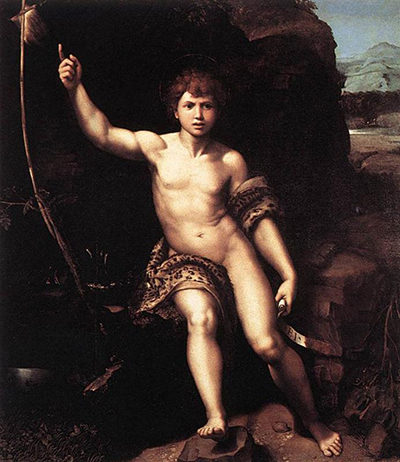St John is one of the most renowned figures in the religious culture. He is was referred to as the patron saint and respected across the globe.
The portrait of St John in the desert was among the wide variety of religious paintings Raphael made in Florence. Being known for his great artworks, he is often the name that most people will mention after Leonardo da Vinci and Michelangelo. In this portrait, Raphael is seen reverting to his great imagination where he visualizes the young St John the Baptist and paints him on a canvas. The portrait has made its rounds around the globe and many people see it more of a great symbol than just a mere painting.
This portrait was created during the high renaissance period and Raphael used his favourite technique of oil on canvas to come up with this classic piece. It is one of those paintings that made him be compared to some of his contemporaries like Titian. He is able to deliver the mood and come up with a fully detailed painting with a wonderful finish. He maintains the quality of the artwork and even without his name being mention anywhere, his signature can be seen all over the painting.
This 165cm by 147cm painting has a lot to be talked about. It is fully detailed and his creativity stretches all over it. Raphael gives us a painting of St John the Baptist seated at the entrance of a cave and a plain surface far beyond with clear skies. He is seen pointing a glittering cross while maintaining his focus elsewhere. The ground around him is bare with no single living plant signifying the desert environment. Just like the painting of the holy family of the oak tree, he is seen holding a scroll, but here there are no visible writings. Raphael concentrates more on John the Baptist and he is seen to capture his masculinity. This is a feature that you can easily capture from the painting without straining.
He then forges ahead to show his intense knowledge of the human body just like Titian did in the portrait Venus of Urbino and the organist. He places every feature exactly where it is supposed to be and the resultant painting is nothing less than amazing. There are particular points of the painting that are well developed with great details to add a visual charm. These are the shoulders, all the way to the neck and the area around the hip on St John's left hand.
They give the painting the realism needed to make it more attractive. The boldest details are seen on St John the Baptists' face and his bare body as a whole. He is very keen to make sure the painting speaks for itself without any explanations. This is one of the main reason he is often compared to some of the best artists in history. The painting is located at Uffizi Gallery in Florence Italy. The same region he began his second painting phase many years ago. There are no known records of who commissioned the painting.




